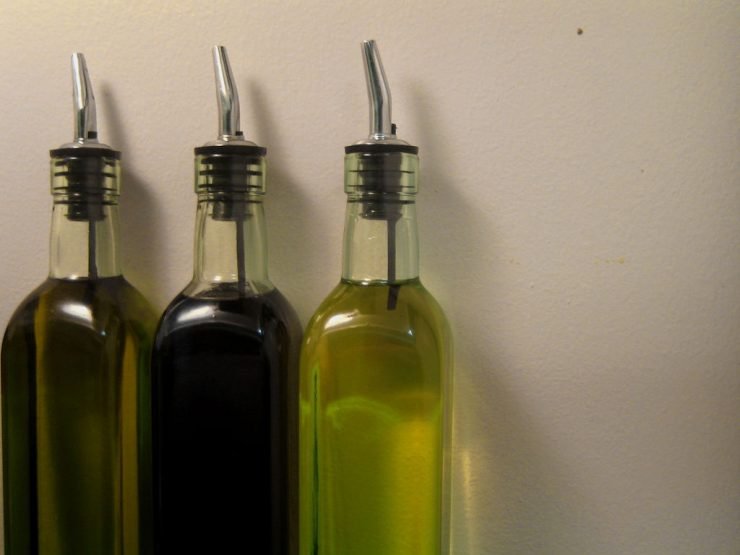Is Canola Oil Healthy? Info from Nina Planck on Healthy Cooking Oils
The information below on healthy cooking oils came in an email newsletter from Nina Planck. This was reprinted here with her permission. You'll read about the smoking points and flavor differences after tests were done on canola oil, olive oil, coconut oil, and pastured butter/ghee…
Order her book here: “Real Food for Mother & Baby.”
Be sure to comment below to tell us what cooking oils you prefer and for which foods!
Here's Nina Planck (I tell everyone she's like a rock star in my world!):
We get fan mail good, bad, and scary – but the best ones lead us to new discoveries and greater expertise. Peter Duffin is the current expert in question, and he operates one of the most widely used bison recipe websites in the world: www.bisonbasics.com. Early last fall, Peter asked us to justify our reasons for avoiding canola oil. To recap for those who don't know, we don't use canola because we have no culinary or nutritional reason to do so! We can get omega-3 fats from wild fish and monounsaturated fats from olive oil – both traditional foods. For a ‘neutral-tasting' frying oil, we prefer olive oil or a blend of butter and olive oil. No, they don't taste ‘neutral' – but neither, in our view, does canola. What does? Water. And we should add one caveat: we don't deep-fry at home, but if we did, we'd probably favor lard for that nutty taste. And we seldom heat oils to the smoking point, because that's a sure sign of damage to delicate fatty acids.
Peter, however, knows all about smoke points, recommends cooking with canola and knows of other experts who are fans as well. We reminded Peter that canola oil is not a traditional food – neither in the quantities consumed, nor in methods of production. And we don't care for the flavor. But Peter is a cook and scientist – think Harold McGee – so he put our skepticism about canola to the test in the kitchen, where it counts. We are happy to present:
Peter Duffin’s Smoke Point Flavor Testing
The test subjects:
- Canola oil (refined and first cold pressed, organic)
- Olive oil (extra virgin and light) (For quality olive oil, visit here.)
- Coconut oil (expeller pressed, organic) (I checked with Peter and he used a refined coconut oil)
- Butter/ghee
The test equipment:
- 12-inch high density Kitchen Aid sauce pan
- Over a 15,000 BTU gas burner
The biggest disappointment: refined canola oil. It can take the heat (around 400F before it started smoking), but it did have a slight chemical after-taste that increased when heated. The organic cold pressed canola oil was a completely different animal – it tasted fine to me before and after heat and had a lower smoke point (around 300F). However, it is hard to find, and five times more expensive than regular refined canola oil (about $16/quart). I guess I can thank Monsanto for that.
I love extra virgin olive oil, but its distinct flavor can be a little overwhelming when used as a cooking medium for pasture raised meat. Especially when used for pan searing purposes.The light olive oil, I don't know why it's even made….a complete loss.
The nicest surprise was the coconut oil… completely neutral, both before and after heating. I was able to take it to 365F before it started smoking. Neutrality is very important in the world of cooking pasture raised steaks; it's the pasture in the meat one wants to taste, not flavor coming from a distinctive tasting oil or fat.
Still a lot of people like the taste of butter, especially if it's organic, even better if it's from grass-fed cows. Ghee is my preference in this case, not the actual butter. (Nothing worse than burnt milk solids. Even if I'm sautéing fish it will be done in ghee every time, not straight butter.) I've read in a few places that one can take ghee to 485F, but so far I have only managed to get it to around 400F or so before it starts to smoke.
The conclusion: for pan-frying grass-fed bison tenderloin, the cooking medium, thanks to the information in Nina's book, will be either ghee or coconut oil. If these are too expensive, or too hard to find, perhaps the best alternative is good old-fashioned unsalted (grass fed) butter. The first choice in frying oil is peanut, with canola a very distant second. Too bad coconut smokes out somewhere between 350F and365F, otherwise I would give it a try – I find you need at least 375F to finish French Fries properly.
A final tip on grass fed meat: the trick is, especially with bison and elk since the meat from both is primarily ‘select' grade, steaks can be seared in a pan, but they are best finished in an oven set at very low heat.
Peter Duffin is an activist for small farming, especially grass fed bison farming. He runs Bison Basics as a non-profit.
Best wishes,
Nina
More you might like:
- Here's where I buy Coconut Oil
- A link from Peter on how to make Ghee (It is expensive to buy so I may try this!) Here's where to buy grassfed ghee.
- Where to buy safe grassfed meat online.
- What is canola oil? Is it good or bad?!
- The olive oil vs. canola oil SMACKDOWN!
(Reprinted with permission from Nina Planck, photo by churl. Creative Commons 2.0)




Mrs. Yoder says
From what I know of Canola (shortened form of Canadian Oil Low Acid), one of the main reasons I avoid it is because it’s processed from genetically altered rapeseed. Apparently back in the 40’s, rapeseed was grown to make oil to use as engine lubricant during the war. After WWII was over, they had to find something to do with it, so companies repackaged it as cooking oil. They did the same basic thing with SLS (from coconuts) which was originally used as an engine degreaser and is now used in toothpastes, shampoo, soap, body washes, etc because it causes foam and bubbles. The American populace got a lot of fun things handed to them as left overs from WWII industrialism.
Anyway, the information I’ve found through various widespread places is that rapeseed is a member of the mustard family and naturally contains high levels of erucic acid which is highly toxic. Animals don’t touch rapeseed in the field and it’s known as being quite deadly. They GMO’d it a bit about 40 years ago and continue to do so today so it wasn’t as toxic and can practically be called another species now. I still maintain that it is toxic for several reasons and it has been linked to heart, thyroid, and kidney problems amongst others. I won’t touch it because it’s not natural and I don’t trust it. I never trusted microwaves, even when I was young, and I was right about that. I felt the same way about margerine and always preferred butter, way before reading anything about Weston A. Price. I think if humans follow their instincts about what they put in their bodies instead of mindlessly feeding, we’d all be healthier over all.
So more important than whether it is a traditional oil, though, is that we should look at what it does. You can’t take a plant with a toxic seed and breed it and tweak it to make magic non-toxic oil. That doesn’t work. There will always be residual problems with it. We are not God and we as humans are not meant to drastically alter what God has made. A little regular plant breeding, weeding out the weak and breeding the strong I can understand. That happens in nature usually and even cross-breeding happens in nature. Drastically altering plants to make brand new ones, however, creates an unknown factor in our health.
Peas and Love,
Mrs. Yoder
Kelly says
Hi Ellen, the main things I’ve read about it:
It’s good because of its high smoke point, but that it should be used in small amounts because it’s high in omega 6’s…
ellen says
I have never like the taste of Canola Oil. Have you tried Rice Bran Oil? It has more antioxidants and vitamin E than olive and canola oil. Look up Rice Oil’s benefits-you will be surprised!!
Anna says
I gave up canola oil ages ago for many of the same reasons mentioned here. For non-cooked foods, I use EV olive oil, unrefined coconut oil, butter, or sometimes some nut oils (walnut, hazelnut, macadamia, etc.).
For baking I use butter, coconut oil, lard, and poultry fat (lard and poultry fat also for roasting).
For stovetop cooking, I generally keep the heat low, rarely going over medium temp settings. Even then, I’m mindful of damaging my fats and oils, so I stick to ghee, coconut oil, and my home-rendered lard (I don’t believe well-raised pork is “dirty”, btw) when I might raise the heat a bit above medium setting. For very low heat cooking I use butter (grass-fed), EVOO, or sometimes a combination of butter and EVOO.
Kelly says
Peter,
I agree with you that a big issue is the refined/GMO oil vs. organic/cold pressed, but because canola oil is such a new oil, I still won’t use either, especially not when I’ve got the others that you mentioned, the traditional oils: ghee & olive oil, and especially coconut oil.
I can’t say that genetic modification has a place in our world – that’s just tinkering in ways we shouldn’t be tinkering. It’s all scary!
Thanks for popping over to my site! 🙂
Kelly
Lisa Sargese says
Ok, you can tell I really, really, really want one of your giveaway copies!!
So far I:
– had already subscribed to Nina Planck’s newsletters
– posted on my blog and linked back here
– subscribed to your blog via email
– follow you on Twitter AND Tweeted with a link here
– friended you on Facebook and updated my status with a link here
– emailed 5 friends about the book and your webpage!
Thanks for doing this!!
–
Lisa Sargese
Peter J. Duffin says
Hi Kelly,
Interesting commentary about canola oil.
First let’s not do any finger pointing at cold pressed organic canola oil. My understadning is that it comes from non-genetically modified plants. It has sweet nutty taste, is a helathy salad oil, but cannot take the heat when used for frying.
Our concern with canola should be directed at the refined oil derived from genetically modified plants. That’s the product most of us see in our grocery stores.
Refined cooking oils have higher smoke points and much longer shelf lives than their unrefined cousins. The refinement process will deoderize an oil and remove contaminants that cause it to break down and go rancid.
The problem here is the refinement process itself. Refinement can involve the use of chemical solvents used to cleanse the oil of so-called impurities. My question is: Does the process add something to the oil in trace amounts, or does the process affect the oil’s basic natural chemistry? It’s very difficult to get a straight answer on that one. Indepedent, unbiased research is something I’m still looking for.
Then there’s the whole issue of using oil seeds from genetically modified plants. This is not only an issue with canola, but also soy and corn oils as well.
Although genetic modification may have it’s place in our world, clearly the jury is still out. The potential for unintended and far reaching consequences is a very real one. Genetic engineering, plant and animal modifications, are areas that deserve our ongoing attention and close monitoring.
In view of the aforementioned, for now it appears our safest choices when it comes to using fats and oils in cooking are ghee (clarified butter), and extra virgin olive oil.
Peter
Reba says
Hey, isn’t lard plain old pork fat. Pork is the most unclean meat around. And…how can it have a nutty flavor? I am confused.
Pigs don’t even sweat (or should I say perspire?) so all the body poisons are retained in their muscles and fat. God knew better than us after all when He said to not eat pork. Just info for everyone one though!!!
Reba
Rosy says
MaryAnne,
I used to feel the same way about canola oil, until I started cooking with coconut oil. I was on a kick with it. When I went back to the conola to use it up, it didn’t tast good at all. It only sat in my cabnet for 2 weeks unused. I gave it away. Now the cold pressed conola is pretty good in Mayo, haven’t cooked with it yet, but I will not be getting it again either.
MaryAnne says
Hi there, i have two cents to add in here too…I don’t completely agree with you. I cook alot of natural latin food and one of the ways to cook it is to line the bottom of a pan with a thin amount of oil and some sugar (it develops alot of smoke due to the sugar)…the corn and veg oils, I never ever buy, but canola oil CAN take the heat. I use olive oil all the time, including to replace it with butter/vice versa. Olive oil has the best benefit (actually, coconut oil, but not everyone can get it), but anyway, there is NO chemical after taste from cooking at a high temp. The stove I have now heats the oil to smoking, but not enough to burn the sugar in the oil like i need, so I skip the sugar and just do the oil…that’s why I say, I disagree about your comment on chemical taste, there is none. I cook with oil daily. Mostly olive oil and where I can’t use that (due to the cooking temps) I use canola oil. I also use coconut oil. so I am quite well versed on their flavors and ability to cook at high temp. well, anyway, that’s the point I wanted to get across here. thanks for the info though.
MaryAnne
Local Nourishment says
I make my own clarified butter to use when I cook. About 90% of the time I cook with coconut oil and about 10% I’ll break out the clarified butter. I make it so my dairy-allergic daughter won’t react to the food, but I’ve found it very good for sauteeing. It’s super easy to make, it kind of makes itself even. Because it has to be heated above 118
Kristin says
Anything the mainstream food sources push, I look at with skepticism.
We use butter or lard primarily for frying. I try and save the lard for biscuits and crusts. And I really should make some ghee, particularly since I’ve got a butter surplus right now.
Bariani olive oil for salad dressings. But I also need to look for some real cream based dressings so I don’t have to mail order the olive oil (of course, we love the stuff). Due to the price, I never cook with the olive oil. We use it raw.
And I just rendered some tallow (suet, actually) to use for deep fat frying. I would like to try making donuts and real potato chips!
Henriette says
Canola oil is VERY BIG in Denmark – one of the reasons is that it grows very well here and that EU gives it lots of subsidies – they say it s as good as Olive oil and there is NOT olive oil enough !? – Well I absolutely hates it and avoid it- so do my bees ;-D sure it makes a lot of honey but the honey is NOT interesting to eat at all ! The only thing I like a bout canola is that the fields are pretty in May and it can work as cheap CO2 friendly gas for cars.
I use:
For frying
Ghee ( I make it myself – easy and I choose what butter source I want)
or virgin coconut oil
For dressing veggies etc efter they are cooked butter or Olive oil.
For salad dressings and mayo Macadamia oil or olive oil or a mixture.
On bread always butter
Baking: butter or Ghee- I often use ghee in recipes that call for oil, since ghee is 100 % fat. and butter is cheaper than Virgin coconut oil.
Henriette
Kelly says
Hi Kristen,
I buy it, but it’s really expensive! Love your new blog carnival idea – perfect!
Kelly
FoodRenegade says
Kelly — You are so awesome! Thanks for posting this. I’ve had a LOT of people ask me about canola oil. My only response thus far has been “It’s not traditional.” Now I have more ammo.
Have you ever made your own ghee? Or do you buy it?
Cheers,
KristenM
(AKA FoodRenegade)
FoodRenegade